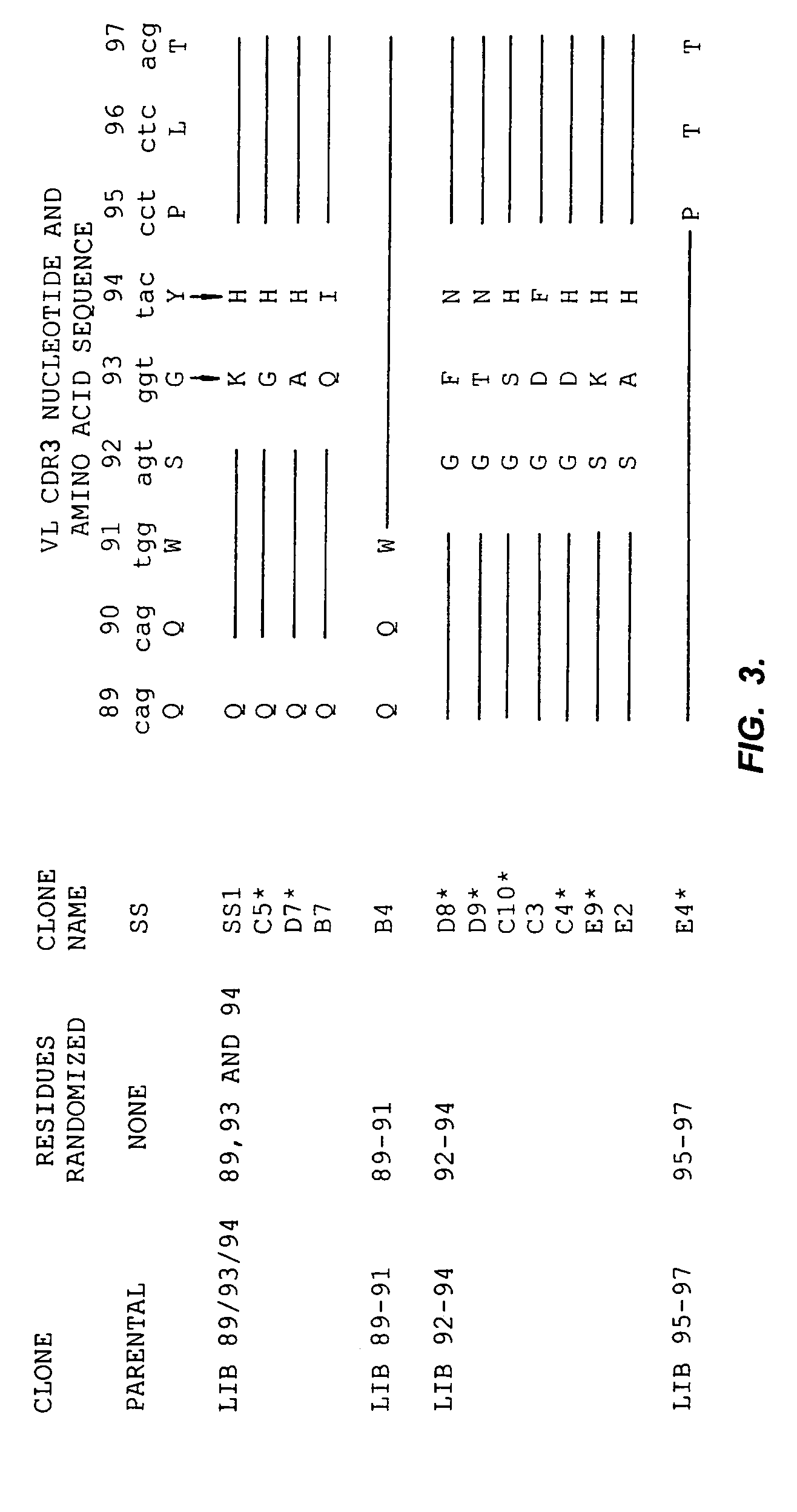Anti-mesothelin antibodies having high binding affinity
an anti-mesothelin and high binding affinity technology, applied in the field of antimesothelin antibodies having high binding affinity, can solve the problems of high mortality rate, unfavorable cancer therapy, and inability to kill healthy cells as well as malignant cells
- Summary
- Abstract
- Description
- Claims
- Application Information
AI Technical Summary
Benefits of technology
Problems solved by technology
Method used
Image
Examples
example 1
Construction of the Libraries
[0185]Of the 32 hotspots in SS(scFv), 14 are located in the VH and 18 in the VL. We chose the CDR3s to begin mutagenesis because they are the major sites of interaction with the antigen. We chose VL CDR3 over VH CDR3 for our initial studies because it undergoes fewer recombination events and is therefore closer to the germline. In the CDR3 of VL there are two hotspots of the A / G-G-C / T-A / T type and one AGT serine codon. We began our experiments by concentrating on the tetranucleotide hotspots in VL CDR3. In our study we randomized all the nucleotides of the codons that form whole or part of the tetranucleotide motif unless there was a special reason not to do so (discussed below).
[0186]The first phage library (Lib 89 / 93 / 94) involved randomizations of codons which are part of two tetranucleotide hotspots, one encoding residues 89 and 90 and the other residues 93 and 94 in the VL. Because Q90 is highly conserved in sub group VI (Johnson et al., in WEIR'S HA...
example 2
Panning of the Libraries and Enrichment of Binders
[0189]The libraries were panned on immobilized recombinant mesothelin. The results of the panning experiments are shown in Table 3. We know that with an input of 2–6×1011 phage the background is usually around 5–6×104. For Lib 89 / 93 / 94 and Lib 92–94 we obtained 2×105 phage from the first panning. This represents an enrichment of about 3-fold of phages that bind mesothelin. At the second round, there was a large increase in enrichment which was 150 and 130-fold, respectively. The enrichment after the third round of panning for these libraries were about 5-fold. The overall enrichment was about 2000. In contrast, for the control libraries there was no enrichment after the first round of panning but thereafter there was a gradual increase in enrichment, 10-fold after second panning and 200-fold after the third. The overall enrichment for both the control libraries was also about 2000-fold. Although the overall enrichment for all the lib...
example 3
Screening of Clones for Mesothelin Binding
[0191]Next, we examined the binding properties of phage selected from each of the different libraries. For each library we screened 23 clones by ELISA from the second and third rounds of the panning. The results of this experiment are shown in FIG. 2.
[0192]FIG. 2B shows the mesothelin binding activity of clones selected after panning of Lib 89 / 93 / 94. As evident from the figure, all 46 clones bound to mesothelin and could be grouped into 4 types: (i) 27 clones had very high ELISA signals (2.3–2.7); (ii) 12 clones with high ELISA signals (1.75–2.2); (iii) 6 clones had ELISA signals comparable to the parental SS(scFv) phage (shown by filled squares) and (iv) one clone had an ELISA signal lower than the wild type parental phage.
[0193]FIG. 2C shows the mesothelin binding activity of phage clones from the Lib 89–91. Of the 46 clones tested, 39 bound mesothelin. None had an ELISA signal greater than the parental clone. 28 of these 39 clones had ELI...
PUM
| Property | Measurement | Unit |
|---|---|---|
| average bond energy | aaaaa | aaaaa |
| temperature | aaaaa | aaaaa |
| temperature | aaaaa | aaaaa |
Abstract
Description
Claims
Application Information
 Login to View More
Login to View More - R&D
- Intellectual Property
- Life Sciences
- Materials
- Tech Scout
- Unparalleled Data Quality
- Higher Quality Content
- 60% Fewer Hallucinations
Browse by: Latest US Patents, China's latest patents, Technical Efficacy Thesaurus, Application Domain, Technology Topic, Popular Technical Reports.
© 2025 PatSnap. All rights reserved.Legal|Privacy policy|Modern Slavery Act Transparency Statement|Sitemap|About US| Contact US: help@patsnap.com



